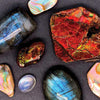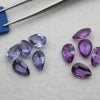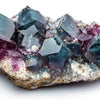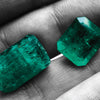Color-Change Gemstones: Nature’s Optical Illusions
- by Greta Fontanella

In a world full of beautiful gemstones, few are as mesmerizing as color-change gems — stones that literally shift hue depending on the light. From the legendary alexandrite to rare sapphires and garnets with dual identities, these gemstones are among the most fascinating and magical treasures of the natural world.
Color-change gems don’t just sparkle — they transform, creating an ever-changing palette on the wearer’s hand, neck, or wrist. This optical phenomenon isn’t just rare — it’s almost surreal.
Let’s explore the science, symbolism, and standout examples of nature’s most chameleon-like stones.
What Is a Color-Change Gemstone?
Color-change gemstones appear different colors under different lighting — typically changing between daylight (cool light) and incandescent or candlelight (warm light). This is known as metamerism, and it occurs due to the gem’s unique absorption of certain wavelengths of light.
Color-change stones are not the same as pleochroic gems, which show different colors from different angles (like iolite or tanzanite). Instead, color-change gems respond to light source, not orientation.
Why It Happens:
-
Different light sources emit different wavelengths.
-
Certain gemstones absorb and reflect light selectively based on their chemical makeup and crystal structure.
-
A stone that looks blue-green in daylight might appear red or purple under incandescent light due to how it interacts with each light spectrum.
Top Color-Change Gemstones
Let’s dive into the most famous and fascinating gems that exhibit this magical behavior:
1. Alexandrite (Chrysoberyl)
Color Change: Green/blue-green → Red/purple
Hardness: 8.5
Sources: Russia, Brazil, Sri Lanka, Tanzania
Rarity: ⭐⭐⭐⭐⭐
The king of color-change stones. Alexandrite is prized not only for its dramatic shift — “emerald by day, ruby by night” — but also for its rarity and royal history. First discovered in Russia’s Ural Mountains in the 1830s, it remains one of the most valuable and collectible gemstones in the world.
Why it changes: The presence of chromium causes alexandrite to absorb yellow and emit green/red depending on light temperature.
Tip: Look for stones with a complete and vivid shift — green to red — with minimal gray or brown masking.

2. Color-Change Garnet
Color Change: Greenish/yellowish brown → Red/purple
Hardness: 6.5–7.5
Sources: Tanzania, Madagascar, Kenya, Sri Lanka
Rarity: ⭐⭐⭐⭐
One of the lesser-known color-change champions, this garnet variety can resemble alexandrite at a fraction of the cost — though top-quality color-change garnets can still be extremely valuable. It’s usually a blend of pyrope and spessartine garnets with vanadium or chromium.
Color-change garnets tend to shift from olive green or brown in daylight to red or purplish red in incandescent light.
Tip: Look for strong saturation and a clear, visible color shift — the rarer the green-to-purple transition, the better.

3. Color-Change Sapphire
Color Change: Blue/violet → Purple/pink
Hardness: 9
Sources: Sri Lanka, Tanzania, Madagascar
Rarity: ⭐⭐⭐
While sapphires are usually known for their stability of color, some rare specimens can exhibit color change — especially blue to purple or violet to reddish pink transitions. These stones are still classified as sapphires (varieties of corundum) but contain trace elements like vanadium that enable the phenomenon.
Tip: These stones are durable and excellent for daily wear, including engagement rings.

4. Color-Change Spinel
Color Change: Grayish blue → Violet or reddish violet
Hardness: 8
Sources: Sri Lanka, Tanzania, Myanmar
Rarity: ⭐⭐⭐⭐
Spinel is gaining popularity for its vibrant hues and lack of treatments. A rare few also show impressive color change — typically shifting between cool grays/blues and reddish purples. Though not as dramatic as alexandrite, they’re admired for their subtle elegance and excellent clarity.
Tip: Untreated color-change spinels with good clarity are investment-worthy and growing in demand.

5. Diaspore / Zultanite (Color-Change Diaspore)
Color Change: Greenish yellow → Pinkish bronze/champagne
Hardness: 6.5–7
Sources: Turkey (exclusive mine), Russia, China
Rarity: ⭐⭐⭐
This relatively new entrant into the jewelry world is a color-change variety of diaspore, trademarked as Zultanite or Csarite in its finest forms. It typically shifts between kiwi green, yellow, champagne, and pinkish tones, depending on the light.
Tip: Due to its lower hardness, this stone is best suited for earrings, pendants, or carefully set rings.

Bonus: Color-Change Fluorite, Andalusite, and Others
While less frequently seen in fine jewelry, a few additional stones exhibit mild to moderate color change:
-
Fluorite – Soft, low durability but notable for educational or collector use.
-
Andalusite – Often confused with pleochroism, it can appear greenish-brown to reddish under different light angles.
-
Labradorite – Not true color change, but exhibits spectral schiller or labradorescence.
How Are Color-Change Stones Valued?
Several factors impact value — more than with typical gems:
-
Strength of Color Change
-
A vivid, complete transition (e.g., green to red) is more valuable than a subtle shift.
-
Graded as weak, moderate, or strong change.
-
-
Hue and Saturation
-
Pure tones are more desirable than murky or grayish colors.
-
Some combinations (like green-to-red) are rarer than others (blue-to-purple).
-
-
Size and Clarity
-
Larger stones (especially alexandrite and spinel) are exponentially more valuable.
-
Eye-clean clarity is preferred, especially for garnets and sapphires.
-
-
Origin
-
Russian alexandrite, Sri Lankan sapphire, or Turkish Zultanite often command premium prices.
-
-
Natural vs. Synthetic
-
Synthetic alexandrite and sapphire are common. Always verify origin with a lab certificate.
-
Jewelry Design Considerations
Because these gems change color with lighting, they are interactive and engaging — ideal for:
-
Statement rings
-
Cocktail earrings
-
Conversation-starting pendants
-
Heirloom pieces
When designing:
-
Use white metals (platinum or white gold) to showcase both colors
-
Incorporate simple designs that allow light to flow through the gem
-
Protect softer stones like diaspore with bezel or halo settings
Tip: Consider pairing with diamonds or light sapphires to contrast and emphasize the color shift.
Symbolism and Meaning
Color-change gems symbolize:
-
Transformation and adaptability
-
Mystery, duality, and balance
-
Emotional resilience and inner strength
In spiritual traditions, they are often seen as stones of awakening and intuition, helping the wearer embrace both light and shadow.
Summary Table
| Gemstone | Color Change | Hardness (Mohs) | Rarity | Best Use |
|---|---|---|---|---|
| Alexandrite | Green → Red | 8.5 | ⭐⭐⭐⭐⭐ | High-end rings, collectors |
| Garnet | Olive → Red | 6.5–7.5 | ⭐⭐⭐⭐ | Rings, earrings |
| Sapphire | Blue → Pink | 9 | ⭐⭐⭐ | Durable daily wear |
| Spinel | Gray/Blue → Violet | 8 | ⭐⭐⭐⭐ | Custom jewelry |
| Zultanite | Yellow → Pink | 6.5–7 | ⭐⭐⭐ | Soft daily wear |
| Fluorite | Blue → Purple | 4 | ⭐⭐ | Collectibles |
- Posted in:
- alexandrite
- collector stones
- color change garnet
- color change gemstones
- color change sapphire
- diaspore
- dual color gems
- gemstone symbolism
- gemstone transformations
- light reactive gemstones
- metamerism gems
- rare gemstones
- spinel gemstone
- zultanite





